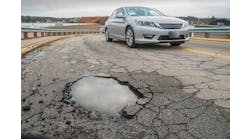In 1982, Orange County’s Public Works Department developed an automated Pavement Management System (PMS). The system objectives were: (1) develop an objective, systematic methodology for determining roadway conditions and defining rehabilitation strategies for all streets and highways within unincorporated Orange County, Calif., and (2) establish a process where a preventive mode of maintenance work is planned and performed for the entire Orange County roadway system.
The county had to plan and optimize expenditures better because of population growth, accompanying traffic and an increase in volume and magnitude of heavy vehicles. The system was implemented in 1982 and is used to plan, organize and schedule improvements.
In 1985, the system received an award from the National Association of Counties. It also has been highlighted in several articles, one of which was the 1994 ROADS & BRIDGES story, PMS pumps up California County’s roadway condition, which highlighted the first 10 years of the system. This article further illustrates results after 20 years of effective pavement maintenance in Orange County.
For over two decades, the PMS has successfully improved the condition of county roadways as well as allowed for efficient use of allocated financial resources by applying life-cycle principles that the county has now proven to be true.
Currently, there are many newer and more complex PMS systems than Orange County’s system that have been developed both in the U.S. and abroad using more recent technology such as geographic information systems, Global Positioning System, deflection testing, laser crack recording, nondestructive testing and integrating with other media system components.
However, Orange County has used and applied the same system with upgrades since 1983 and has seen and documented the benefits of using a systematic process based on a combination of a logical approach and good engineering practice. The future application of these new technologies could present even further opportunities for efficiencies than has already been achieved by Orange County, but the key factor is to apply and use the system concepts in actually performing maintenance work. The consistent application of the system to improve streets and roads for the last two decades has been successful for Orange County and is documented and proven.
How they slice it
In early 1981, Orange County officials concluded that the condition of the roadway network was unacceptable and the growth in the county’s population and traffic would further aggravate the deterioration of the roadway system. The Orange County Public Works Department had a detailed roadway inventory on their VAX computer system but lacked information on pavement condition. Their inventory had information on each roadbed’s width, structural section, traffic and other physical features along with dates of prior improvements. Other files were available with general soils and heavy vehicle volume information. However, this database was not utilized directly in planning maintenance and rehabilitation strategies.
Prior to using an automated PMS, the approach to planning and repairing roadways was to utilize the expertise of roadway maintenance supervisors and technicians to plan to repair streets from selected lists for various types of improvements and match the proposed improvements to the financial resources available. This system was a reactive process based on good, but subjective, criteria of several maintenance staff.
The Orange County Public Works Department decided to prepare a more structured process that could utilize both database information and staff expertise. The county decided to automate components of this process and hire a consultant to design a workable system for both the computer system and implementation process. One of the goals was to utilize the existing county databases as much as possible and work with county staff to develop a system explicitly for Orange County. The consultant’s role was to design the processes and work with county staff to program and implement the software, collect data and evaluate and select projects.
The system was finalized in 1983 and data collected for the first condition survey were entered into the system to generate reports on deficiencies, improvements and estimated priorities. Field-technical personnel were selected by the county to operate the system and to integrate and handle data collection and PMS operations, as well as field inspection of seals, overlays and roadway reconstruction.
This process is now one function. The PMS contract preparation and administration are handled by three staff members. The county-maintained roadway system now includes 312 road-miles of county roadways with another 240 miles of city streets under contract, and over 10 million sq ft of parking lots and trails in county parks.
The Orange County PMS is a combination of manual and automated processes with data collection and field data gathered and compiled in the computerized processing system. The software, designed by a consultant and programmed by county staff, uses many existing county database files.
“The PMS success is due to a combination of management support and having an understandable system that has helped provide a consistent approach to maintenance of county roadways,” said Bill Hisey, Resources and Development Management Department/Operations & Maintenance (RDMD/O&M) manager.
Field evaluations are performed annually by county staff using a documented process that qualifies the pavement distresses, quantifies the amount and rates the severity. Arterials are reviewed each year while local streets are on a two-year cycle. During the field review, condition data is collected on each roadway segment for nine various types of distress, observing both the severity and the extent of the distress. The data is stored in the system’s database that is matched to the roadway, traffic and soils information. Utilizing several algorithms, several different reports can be generated by the system. Among the various types of information is a condition report highlighting the condition of all roadways, an improvement report indicating estimated improvement types and a priority report giving guidance to a user-based cost-benefit analysis. These reports can be sorted by political jurisdiction, roadway type, improvement and supervisory district as well as selectively choosing geographical areas.
Efforts also are made by system technicians to utilize life-cycle evaluations in preparing yearly contracts. In addition, a systematic scheduling of asphalt seal coats based on seven-year cycles and an estimate of overlays based on a pavement rehabilitation cycle of 21 years are done. The combination of identified needs from PMS outputs and these cyclical maintenance concepts are compiled by staff into manageable contracts (50,000 tons) and let on an annual basis.
Dripping with success
The system has succeeded for a number of reasons. The Orange County board of supervisors made roadway maintenance a funding priority, committing increased funding for a six-year period to improve the roadway systems after the initial PMS study results in 1983. After four years, funding requirements were reduced by 30%, and then two years later by 50% more as the systematic approach to implementing projects became effective.
Also, the system design and implementation were enhanced by representatives from several county divisions such as computer services, operations, construction and design who participated in the development. This involvement allowed many processes to be simplified and integrated. Next, this group accepted the idea of utilizing automated computer systems to perform previously complicated manual steps. Finally, operations and maintenance management allowed the staff to apply the system logic to help determine which roadways should be improved. The staff was given direction, but allowed to make most of the detail project location and improvement decisions.
The system was easily understood by managers, engineers and technicians. The components are based on a defined and documented logical approach. Many personnel involved in development are now the same individuals utilizing and operating the system. The system was designed for local conditions in Orange County, not for the entire U.S. This minimized the need for factors irrelevant to the southern California environment, such as freeze-thaw cycles and certain soil conditions.
Thirdly, success was achieved only through consistent use of the system with little major logic changes. For over a 20-year period, the same process has been applied with only minor variations to the computer system (for speed and clarity), which has allowed the county to apply proven and consistent techniques and processes. Following this same process with little logic change allows for direct comparison and utilization of data collected throughout the entire period. One key factor in this process has been the consistency in application of the system as well as data collection. The staff performing this operation has remained on the team throughout the period, allowing for a “one-eye” approach, i.e., all roadways have had the “same eyes” evaluate them over the entire period.
The last reason for success has been the direct application of the system operation integration with the staff that implements the capital improvement program. Most agencies separate these functions, requiring the PMS staff to coordinate, educate and convince others on the use of the candidate projects in the PMS directly in the capital improvement program to utilize the system.
In Orange County, the same staff is involved throughout all phases of both the evaluation and subsequent construction contracts. The PMS staff actually prepares all seal and overlay contracts, utilizing information they have generated. Further, the staff is involved in the construction phase and monitoring of the success of recommended actions. This integrated approach over 1984-2004 resulted in 105 contracts for over 1,150 miles of resurfacing and seal work.
System ripens
The system success over the last two decades is depicted in the graph in Figure 1. Orange County roadways were systematically rated over 20 years in four general categories: good, fair, poor and critical. The good category represented those areas that required minimal maintenance; other categories represented the necessity for progressive maintenance and rehabilitation strategies. The results of using the PMS have demonstrated an improved roadway system with the good- and fair-rated roadways improving and the poor and critical ones decreasing. As shown in the graph, the actual amount of pavement in poor and critical categories decreased to 4% of the system from 24%, while at the same time the good category increased to 72% from 50%. It is clear that pavement condition has dramatically improved.
Another positive result has been the reduction in maintenance effort. Initially, after the PMS program was implemented, increased rehabilitation and maintenance expenditures were required. However, systematic routine applications of seals and overlays have stabilized the amount of effort required. Figure 2 shows the change in expenditures per road mile, adjusted to constant dollars using the ENR construction index. This is further demonstrated in that expenditures of approximately $4,000 per road mile in the period 1982-1983 went to nearly $16,000 per road mile in 1986-1988, to a downward trend as roadway maintenance became cyclical to under $6,000 per road mile again. The roadway condition continues to improve while maintenance efforts have shifted to more systematic seal and overlay projects instead of reconstruction.
The number and complexity of contracts also have been reduced as street improvements are planned in a preventive manner by scheduling repair and rehabilitation work on both a time and geographical-area basis.
Another result has been the county’s shift from utilizing six asphalt repair crews to perform hand patch and remove and replace operations to now utilizing contract work exclusively. According to RDMD/O&M’s Hisey, “Dollars spent on road maintenance and overlays have been reduced as we have systematically used the system and repaired and fixed high-priority roads.”
Orange County’s overall roadway condition has improved materially since the systematic approach was implemented in 1982. The 20 years of information has documented that preventive maintenance does work. Other agencies have the same potential to reduce maintenance costs and improve the roadway infrastructure if they can create a usable system that is tailored to their specific needs and designed to be workable for their operations and management staff. The information must be used to provide management with relevant condition, improvement, cost and priority data and then management must make decisions for this system to work.

